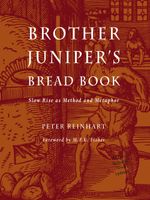Advertisement
Slow Rise: A Beginning
Appears in
Published 1991
I learned about slow rise by reading Julia Child, who learned it from chefs, who learned it from bakers, who learned it from others before and before them. It is a principle, like a great cosmic law, that yields marvelous fruits when applied in conformity with other laws of baking and it is a principle that can, like all true, principles, be transposed into the moral and ethical realms of politics, religion, work, and life in general. Slow rise is like saying “the Way,” Tao, or inshā’a Allāh.
In breadmaking it works like this: You take flour, water, salt, and yeast, mix them together in the proper proportions, and form the dough into a ball. You then put it out of the way and forget about it for about an hour and a half. What you do not do is rush it by warming it up; just let it grow at its own slow pace. Then, when it has doubled in size, knock it down and form it into a ball again. Knocking it down causes it to develop character. If you bake it after one rise it will work but will not be very interesting. It needs more time. After another hour and a half the dough will once more double in size. Knock it down again. By now you have the makings of a very good bread, so form it into loaves and let it rise again for another hour, only do it right on the baking pan (so you can put it directly into the oven). Then you bake it. When it comes out of the oven, you have to wait because the bread is still cooking while it is cooling down. After another thirty or forty minutes, you can finally eat the bread.

